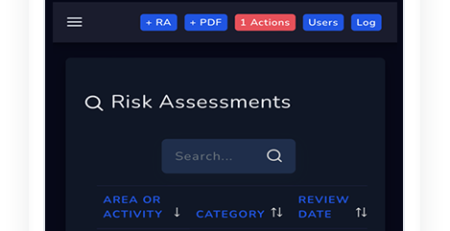DSE Compliance: What you need to know
DSE Compliance: What you need to know
“This guide aims to provide a comprehensive overview of DSE compliance and the responsibilities of employers in this regard.”
If you use a laptop, tablet, or smartphone, then you will need to provide a DSE assessment for your staff. This document defines DSE and lays forth the responsibilities of employers in relation to the management and control of DSE compliance.
 The use of display screen equipment (DSE) in contemporary workplaces has become increasingly common, with desktop computers, laptops, tablets, and smartphones being widely used. However, the improper use of DSE can lead to various health problems for employees, such as back pain, upper limb issues, exhaustion, and eye strain. In order to ensure the safety and well-being of employees, employers have a legal responsibility to manage and control DSE-related hazards. This guide aims to provide a comprehensive overview of DSE compliance and the responsibilities of employers in this regard.
The use of display screen equipment (DSE) in contemporary workplaces has become increasingly common, with desktop computers, laptops, tablets, and smartphones being widely used. However, the improper use of DSE can lead to various health problems for employees, such as back pain, upper limb issues, exhaustion, and eye strain. In order to ensure the safety and well-being of employees, employers have a legal responsibility to manage and control DSE-related hazards. This guide aims to provide a comprehensive overview of DSE compliance and the responsibilities of employers in this regard.
“According to official statistics from the Health and Safety Executive (HSE), in 2019/20, 480,000 British workers experienced musculoskeletal disorders (MSDs). This resulted in 8.9 million missed workdays, which averages 18.4 days lost for every case of MSD.”
It is mandatory that all personnel receive DSE training if they often utilise display screen technology in the course of their job. Participants in our Display Screen Equipment (DSE) Training Course will learn how to use display screen equipment safely, how to recognise potential hazards, and how to implement basic ergonomic concepts to prevent difficulties.
The term “DSE compliance”.
Everything with a graphic or alphanumeric display screen, such as laptops, touchscreens, and display screens, is considered display screen equipment according to the HSE.
Typical components of DSE are:
- Screens used in computers
- Laptops
- Training PCs
- display units for televisions
- Mobile phones
- Digital-screen displays
- video surveillance systems
So, who exactly uses DSE?
No matter where an employee uses their display screen equipment for work purposes for an hour or more at a time, employers are legally obligated to safeguard them from the health dangers linked to it. That encompasses:
- On a stationary desk.
- Staff members who work remotely.
- Members of the homework community.
- Sharing a desk during the day.
While all employees should be protected when using display screen equipment, employers should pay extra attention to pregnant workers, people with pre-existing musculoskeletal problems, and those with ocular conditions, as they may experience students doing their own homework using the devices.
Concerns about the potential health effects of using electronic devices with screens
Poor and awkward postures, pain, discomfort, or chronic conditions might result from an employee utilising a poorly constructed workstation or experiencing prolonged bouts of use. Some examples are:
- A chair that is either too big or has bad construction.
- The distance between the computer and the mouse is too great.
- You have misaligned the height of your laptop screen.
- Working without breaks leads to unrealistically high rates of productivity.
Back, neck, shoulder, arm, and hand pain are some of the MSDs that can develop as a result of this. Repeated stress injuries (RSIs) are a real thing.
Visual issues, such as tired or painful eyes, eye strain, and exhaustion that may induce headaches, can result from prolonged screen use unless precautions are taken.
In addition to endangering workers’ health, the hazards posed by display screen technology can have a negative impact on businesses’ bottom lines through absenteeism and missed workdays.
Screen display device requirements
The Display Screen Equipment Regulations 1992 address the responsibilities of employers regarding display screen equipment. Employees whose workdays include more than an hour of screen time are subject to this policy.
Workers who use display screen equipment infrequently, for brief periods, or who are not dependent on it to perform their work functions are exempt from the DSE requirements.
Legally, businesses are obligated to:
- Evaluate each workstation.
- Lessen potential dangers by instituting measures like scheduled breaks from screen time for workers.
- Get an eye exam scheduled for every worker who requests one, and if they need corrective lenses specifically for DSE work, give them the necessary eyewear.
- Employees should be trained on display screen equipment.
What constitutes sound DSE procedures?
1. The importance of regular evaluations: Businesses should explain why it is necessary to evaluate each workstation, even for workers who use display screen equipment infrequently or for brief periods. This can help ensure a safe and ergonomic working environment for all employees.
2. Implementing preventive measures: To mitigate potential dangers associated with prolonged screen time, businesses should consider instituting measures such as scheduled breaks from using display screen equipment. Exploring the benefits of these breaks and their impact on productivity could be an interesting topic to expand upon.
3. Promoting eye health in the workplace: Expanding on the requirement for businesses to provide eye exams for workers who request them can delve into discussing the importance of regular eye check-ups in relation to DSE work. Additionally, exploring how providing corrective lenses specifically designed for DSE work can contribute to reducing eye strain and other related issues would be valuable information.
4. Effective training programmes: Employees need proper training on how to use display screen equipment correctly and safely. Writing about what constitutes sound DSE procedures in terms of employee training can encompass topics like ergonomics, posture, adjusting monitor settings, and managing workspace organisation effectively.
5. Adapting DSE procedures based on industry-specific needs: Discussing how different industries may require unique considerations when implementing DSE procedures could provide useful insights tailored to specific sectors, such as design or customer service centres, where extensive computer usage is common.
Employers are obligated to fulfil different regulatory requirements under the Display Screen Equipment Regulations 1992. OpsPal could help you with this. They consist of:
Equipment workstation evaluations with display screens
If an employee’s job duties include utilising DSE all day, every day for at least an hour, the employer is required to perform a DSE workstation evaluation. Someone with the necessary expertise must do the assessment in order to detect potential dangers. Effective controls must be put in place to handle any identified risks.
How does a DSE evaluation work?
An evaluation by DSE must take a look at:
- The full workstation, including the equipment and furniture,.
- The conditions at work, including the ambient light and noise levels,.
- At the workstation, the chores are being finished.
- Persons with disabilities or who are pregnant may have specific needs.
Companies must also do a DSE evaluation when:
- We have put up a new workstation.
- The company welcomes a new employee.
- The setup or operation of an existing workstation is altered.
- The user reports feeling uncomfortable or in pain.
As part of the evaluation process, we check to make sure:
- Computer mice and keyboards are at a relaxed angle.
- The screen characters are crisp, clear, and flicker-free.
- Reflections and glare are not an issue on these screens.
- All of the required tools, office supplies, and paperwork can fit on the available work surfaces.
Alternatively, you can utilise an online workstation assessment system that automates the procedure and eliminates paperwork, or you can download the HSE’s workstation checklist.
Note down all of your noteworthy discoveries. Keeping track of employee evaluations is mandatory for businesses with five or more workers.
On a frequent basis, you ought to review your evaluation.
Risk management
You are responsible for addressing hazards that an evaluation finds. Possible actions to take include DSE compliance:
- Providing replacement or repaired equipment.
- Instruction on proper body alignment and the use of various pieces of machinery or computer programmes.
- I am suggesting that the worker change up their workspace.
- Rearranging electrical outlets to provide room for equipment relocation.
- Enhancing heating, cooling, lighting, and ventilation.
Intermissions and session shifts
Maintaining a regular schedule of breaks or changes of activity is a legal requirement for employers who use DSEs. They are able to move about, stretch, and alter their posture because of this. While the Health and Safety Executive (HSE) does not have specific regulations about break durations, they do recommend that workers take shorter breaks more frequently rather than longer ones less frequently.
The majority of workers can multitask by using DSEs for things like attending meetings and making phone calls. Otherwise, they ought to have scheduled frequent intervals or changes of direction.
Homeworkers
It is the legal obligation of employers to handle the risks related to DSE for remote workers, just as they are for employees working on company property.
Workstation assessments, along with the provision of suitable equipment and training on control measures that may be necessary, are an employer’s responsibility for workers who work from home permanently or for an extended period of time.
Even though controls may be more in line with training and developing excellent ergonomic principles to place workers at work from time to time, assessments are still necessary for employees operating in an agile or hybrid fashion.
Optical examinations
If an employee uses a DSE and requests an eye examination, their employer is required by law to notify them of their policy regarding eye exams and make arrangements to provide one. A professional eye exam by a doctor or optometrist should be considered a test. Either the company can arrange the exams themselves or they can reimburse the employee if the employee arranges their own.
The company ought to pay for the cost of corrective lenses for workers who require them because of the distance from their screens.
Training: It is mandatory by law to provide training on display screen equipment (DSE) to personnel who use DSE. The dangers of DSE and how to protect yourself from them should be part of any training programme. It ought to contain guidance regarding
- Standing tall is the correct way to arrange a desk. ion. How to set up your chair, keyboard, and screen so that they are all easy on the body. Changing activities and taking breaks are important. i.e. ways to report issues. What was found during the workstation assessment, and what controls would be implemented?
- OpsPal could help you with this and so many other things, read 10 reasons why we built OpsPal
- Or book in here so we can demo the product to you
- Want to understand a little more about OpsPal? Click here













